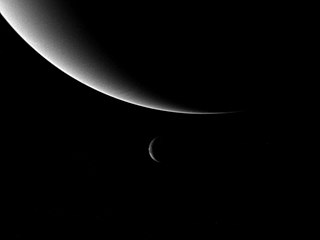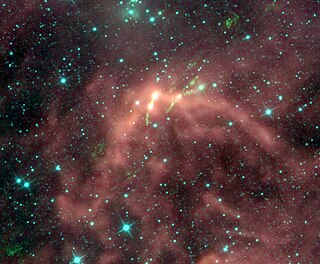Related Research Articles

In astronomy, the main sequence is a continuous and distinctive band of stars that appears on plots of stellar color versus brightness. These color-magnitude plots are known as Hertzsprung–Russell diagrams after their co-developers, Ejnar Hertzsprung and Henry Norris Russell. Stars on this band are known as main-sequence stars or dwarf stars. These are the most numerous true stars in the universe, and include the Sun.

A star is an astronomical object comprising a luminous spheroid of plasma held together by its gravity. The nearest star to Earth is the Sun. Many other stars are visible to the naked eye at night, but their immense distances from Earth make them appear as fixed points of light. The most prominent stars have been categorised into constellations and asterisms, and many of the brightest stars have proper names. Astronomers have assembled star catalogues that identify the known stars and provide standardized stellar designations. The observable universe contains an estimated 1022 to 1024 stars. Only about 4,000 of these stars are visible to the naked eye, all within the Milky Way galaxy.

A supernova is a powerful and luminous explosion of a star. It has the plural form supernovae or supernovas, and is abbreviated SN or SNe. This transient astronomical event occurs during the last evolutionary stages of a massive star or when a white dwarf is triggered into runaway nuclear fusion. The original object, called the progenitor, either collapses to a neutron star or black hole, or is completely destroyed. The peak optical luminosity of a supernova can be comparable to that of an entire galaxy before fading over several weeks or months.

Stellar evolution is the process by which a star changes over the course of time. Depending on the mass of the star, its lifetime can range from a few million years for the most massive to trillions of years for the least massive, which is considerably longer than the age of the universe. The table shows the lifetimes of stars as a function of their masses. All stars are formed from collapsing clouds of gas and dust, often called nebulae or molecular clouds. Over the course of millions of years, these protostars settle down into a state of equilibrium, becoming what is known as a main-sequence star.

A planetary nebula is a type of emission nebula consisting of an expanding, glowing shell of ionized gas ejected from red giant stars late in their lives.

Star formation is the process by which dense regions within molecular clouds in interstellar space, sometimes referred to as "stellar nurseries" or "star-forming regions", collapse and form stars. As a branch of astronomy, star formation includes the study of the interstellar medium (ISM) and giant molecular clouds (GMC) as precursors to the star formation process, and the study of protostars and young stellar objects as its immediate products. It is closely related to planet formation, another branch of astronomy. Star formation theory, as well as accounting for the formation of a single star, must also account for the statistics of binary stars and the initial mass function. Most stars do not form in isolation but as part of a group of stars referred as star clusters or stellar associations.

An astronomical object, celestial object or heavenly body is a naturally occurring physical entity, association, or structure that exists in the observable universe. In astronomy, the terms object and body are often used interchangeably. However, an astronomical body or celestial body is a single, tightly bound, contiguous entity, while an astronomical or celestial object is a complex, less cohesively bound structure, which may consist of multiple bodies or even other objects with substructures.
The carbon-burning process or carbon fusion is a set of nuclear fusion reactions that take place in the cores of massive stars (at least 8 at birth) that combines carbon into other elements. It requires high temperatures (> 5×108 K or 50 keV) and densities (> 3×109 kg/m3).

NGC 300 (also known as Caldwell 70) is a spiral galaxy in the constellation Sculptor. It is one of the closest galaxies to the Local Group, and probably lies between the latter and the Sculptor Group. It is the brightest of the five main spirals in the direction of the Sculptor Group. It is inclined at an angle of 42° when viewed from Earth and shares many characteristics of the Triangulum Galaxy. It is 94,000 light-years in diameter, somewhat smaller than the Milky Way, and has an estimated mass of (2.9 ± 0.2) × 1010M☉.

The horizontal branch (HB) is a stage of stellar evolution that immediately follows the red-giant branch in stars whose masses are similar to the Sun's. Horizontal-branch stars are powered by helium fusion in the core and by hydrogen fusion in a shell surrounding the core. The onset of core helium fusion at the tip of the red-giant branch causes substantial changes in stellar structure, resulting in an overall reduction in luminosity, some contraction of the stellar envelope, and the surface reaching higher temperatures.

The Kepler space telescope is a retired space telescope launched by NASA in 2009 to discover Earth-size planets orbiting other stars. Named after astronomer Johannes Kepler, the spacecraft was launched into an Earth-trailing heliocentric orbit. The principal investigator was William J. Borucki. After nine and a half years of operation, the telescope's reaction control system fuel was depleted, and NASA announced its retirement on October 30, 2018.

The definition of planet, since the word was coined by the ancient Greeks, has included within its scope a wide range of celestial bodies. Greek astronomers employed the term ἀστέρες πλανῆται, 'wandering stars', for star-like objects which apparently moved over the sky. Over the millennia, the term has included a variety of different objects, from the Sun and the Moon to satellites and asteroids.

The Henyey track is a path taken by pre-main-sequence stars with masses greater than 0.5 solar masses in the Hertzsprung–Russell diagram after the end of the Hayashi track. The astronomer Louis G. Henyey and his colleagues in the 1950s showed that the pre-main-sequence star can remain in radiative equilibrium throughout some period of its contraction to the main sequence.

A super-Earth is an extrasolar planet with a mass higher than Earth's, but substantially below those of the Solar System's ice giants, Uranus and Neptune, which are 14.5 and 17 times Earth's, respectively. The term "super-Earth" refers only to the mass of the planet, and so does not imply anything about the surface conditions or habitability. The alternative term "gas dwarfs" may be more accurate for those at the higher end of the mass scale, although "mini-Neptunes" is a more common term.

L1014 is a dark nebula in the Cygnus constellation. It may be among the most centrally condensed small dark clouds known, perhaps indicative of the earliest stages of star formation processes. This cloud harbors at its core a very young low-mass star named L1014 IRS; some astronomers have suggested that this object may be a brown dwarf or even a rogue planet at the earliest stage of its lifetime.

Barnard 68 is a molecular cloud, dark absorption nebula or Bok globule, towards the southern constellation Ophiuchus and well within our own galaxy at a distance of about 500 light-years, so close that not a single star can be seen between it and the Sun. American astronomer Edward Emerson Barnard added this nebula to his catalog of dark nebulae in 1919. His catalog was published in 1927, at which stage it included some 350 objects. Because of its opacity, its interior is extremely cold, its temperature being about 16 K (−257 °C/-431 °F). Its mass is about twice that of the Sun and it measures about half a light-year across.

A red giant is a luminous giant star of low or intermediate mass in a late phase of stellar evolution. The outer atmosphere is inflated and tenuous, making the radius large and the surface temperature around 5,000 K or lower. The appearance of the red giant is from yellow-white to reddish-orange, including the spectral types K and M, sometimes G, but also class S stars and most carbon stars.

An exoplanet is a planet located outside the Solar System. The first evidence of an exoplanet was noted as early as 1917, but was not recognized as such until 2016; no planet discovery has yet come from that evidence. What turned out to be the first detection of an exoplanet was published among a list of possible candidates in 1988, though not confirmed until 2003. The first confirmed detection came in 1992, with the discovery of terrestrial-mass planets orbiting the pulsar PSR B1257+12. The first confirmation of an exoplanet orbiting a main-sequence star was made in 1995, when a giant planet was found in a four-day orbit around the nearby star 51 Pegasi. Some exoplanets have been imaged directly by telescopes, but the vast majority have been detected through indirect methods, such as the transit method and the radial-velocity method. As of 1 October 2022, there are 5,197 confirmed exoplanets in 3,833 planetary systems, with 840 systems having more than one planet. This is a list of the most notable discoveries.
L183 or L134N is a much-studied pre-stellar core in the constellation Serpens Cauda 360 light-years away. This massive accumulation of gas and dust was the interstellar object in which the phenomenon of coreshine was first investigated by astronomers and produced a new means of probing its previously opaque core.

The dark nebula Barnard 203 or Lynds 1448 is located about one degree southwest of NGC 1333 in the Perseus molecular cloud, at a distance of about 800 light-years. Three infrared sources were observed in this region by IRAS, called IRS 1, IRS 2 and IRS 3.
References
- ↑ "NAME LDN 1448 IRS 2E". SIMBAD . Centre de données astronomiques de Strasbourg . Retrieved 2016-12-23.